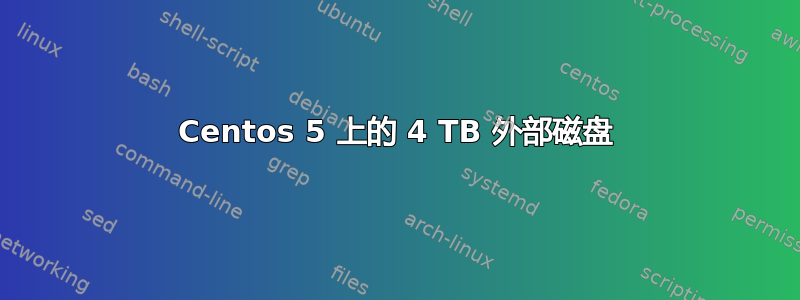
我有一台运行 CentOS 5(内核 2.6.18-92.el5)的旧服务器。它正在运行一个旧版应用程序,所以我还不能淘汰它。我曾将一个 2 TB 的 USB 磁盘连接到它进行备份,现在磁盘几乎已满。
我买了一个新的 4 TB 磁盘,但操作系统只将其检测为 2TB。我知道 fdisk 不支持超过 2TB 的分区,但我使用 parted 也无济于事。
有什么解决方法可以让操作系统读取 4 TB 的全部空间吗?
来自 dmesg:
usb-storage: device found at 15
usb-storage: waiting for device to settle before scanning
Vendor: Seagate Model: Backup+ Desk Rev: 040B
Type: Direct-Access ANSI SCSI revision: 06
sdc: Spinning up disk....ready
sdc : very big device. try to use READ CAPACITY(16).
sdc : READ CAPACITY(16) failed.
sdc : status=0, message=00, host=5, driver=00
sdc : use 0xffffffff as device size
SCSI device sdc: 4294967296 512-byte hdwr sectors (2199023 MB)
parted /dev/sdc 打印
Model: Seagate Backup+ Desk (scsi)
Disk /dev/sdc: 2199GB
Sector size (logical/physical): 512B/512B
Partition Table: gpt
Number Start End Size File system Name Flags
1 17.4kB 2100GB 2100GB primary
Information: Don't forget to update /etc/fstab, if necessary.
答案1
确保您使用的ext3文件系统或某些支持 2TB 以上的文件系统。
使用以下命令创建大于 2TB 的分区(GPT)parted:
https://sakafi.wordpress.com/2008/08/23/how-to-use-parted-for-creating-patition-larger-that-2-tb/
网站消失时的副本:
To create partitions larger than 2TB we need to use GPT labels. Standard fdisk doesn’t understand GPT labels so we need to use parted.
Here we are going to partition the disk /dev/sdb
root@localhost ~> parted /dev/sdb
This will bring up parted. Type help to view the commands in parted prompt.
(parted) help
check NUMBER do a simple check on the file system
cp [FROM-DEVICE] FROM-NUMBER TO-NUMBER copy file system to another partition
help [COMMAND] prints general help, or help on COMMAND
mklabel,mktable LABEL-TYPE create a new disklabel (partition table)
mkfs NUMBER FS-TYPE make a FS-TYPE file system on partititon NUMBER
mkpart PART-TYPE [FS-TYPE] START END make a partition
mkpartfs PART-TYPE FS-TYPE START END make a partition with a file system
move NUMBER START END move partition NUMBER
name NUMBER NAME name partition NUMBER as NAME
print [free|NUMBER|all] display the partition table, a partition, or all devices
quit exit program
rescue START END rescue a lost partition near START and END
resize NUMBER START END resize partition NUMBER and its file system
rm NUMBER delete partition NUMBER
select DEVICE choose the device to edit
set NUMBER FLAG STATE change the FLAG on partition NUMBER
toggle [NUMBER [FLAG]] toggle the state of FLAG on partition NUMBER
unit UNIT set the default unit to UNIT
version displays the current version of GNU Parted and copyright information
root@localhost ~> parted /dev/sdb
GNU Parted 1.8.1
Using /dev/sdb
Welcome to GNU Parted! Type ‘help’ to view a list of commands.
(parted)
To change the label to gpt we run the following command:
(parted) mklabel gpt
Next run the print command: This will list the disk geometry. Please note the size listed:
(parted) print
Model: Adaptec raid5-1 (scsi)
Disk /dev/sdb: 10.7TB
Sector size (logical/physical): 512B/512B
Partition Table: gpt
Number Start End Size File system Name Flags
This will tell us where to start and end the partitions. To create one huge partition ( 8 Tb = 8388608 bytes) run the following commands:
(parted) mkpart primary 0 8388607.000
The command reads as make a primary partition, start at 0 and end at 8388607.000
Also, if you are making a partition for a device smaller than the limit from the notes below, you can use the following if the geometry doesn’t show like it does above. Just exit out of parted, and run this from a shell:
root@localhost ~> parted -s — /dev/sdb mkpart primary ext3 0 -1
This will take the whole disk for creating the partition.
The parition has been created and now you can quit parted:
(parted) quit
Now all that has to be done is to format the partition:(the -m swith tells mkfs to only reserve 1% of the blocks for the super block)
root@localhost ~> mkfs.ext3 -m1 /dev/sdb1
mke2fs 1.39 (29-May-2006)
Filesystem label=
OS type: Linux
Block size=4096 (log=2)
Fragment size=4096 (log=2)
1024000000 inodes, 2047999751 blocks
20479997 blocks (1.00%) reserved for the super user
First data block=0
Maximum filesystem blocks=4294967296
62500 block groups
32768 blocks per group, 32768 fragments per group
16384 inodes per group
Superblock backups stored on blocks:
32768, 98304, 163840, 229376, 294912, 819200, 884736, 1605632, 2654208,
4096000, 7962624, 11239424, 20480000, 23887872, 71663616, 78675968,
102400000, 214990848, 512000000, 550731776, 644972544, 1934917632
Writing inode tables: done
Creating journal (32768 blocks): done
Writing superblocks and filesystem accounting information: done
This filesystem will be automatically checked every 38 mounts or
180 days, whichever comes first. Use tune2fs -c or -i to override.
Mount the disk
root@localhost ~> mount /dev/sdb1 /disk1
root@localhost ~> df -h
Filesystem Size Used Avail Use% Mounted on
/dev/sda3 240G 2.3G 225G 2% /
/dev/sda1 996M 45M 900M 5% /boot
tmpfs 2.0G 0 2.0G 0% /dev/shm
/dev/sdb1 7.6T 177M 7.5T 1% /disk1
答案2
看来我至少需要 2.6.32 内核才能支持更大的磁盘。我的服务器目前有 2.6.18-92.el5:https://unix.stackexchange.com/questions/150699/harddisk-not-recognized-filesystem-too-large-to-mount-safely-on-this-system
具有旧版 BIOS 和 MBR 分区表方案的旧版 Linux 内核版本(所有 2.4 和 2.6.32 之前的版本)计算环境在 2.19 TB 时会遇到障碍,因为它们最多只能寻址 232 个逻辑块。请确保使用支持大于 2.19 TB 的驱动器的内核。2010 年 4 月之后发布的内核支持使用 4096 个扇区大小的大容量驱动器。


